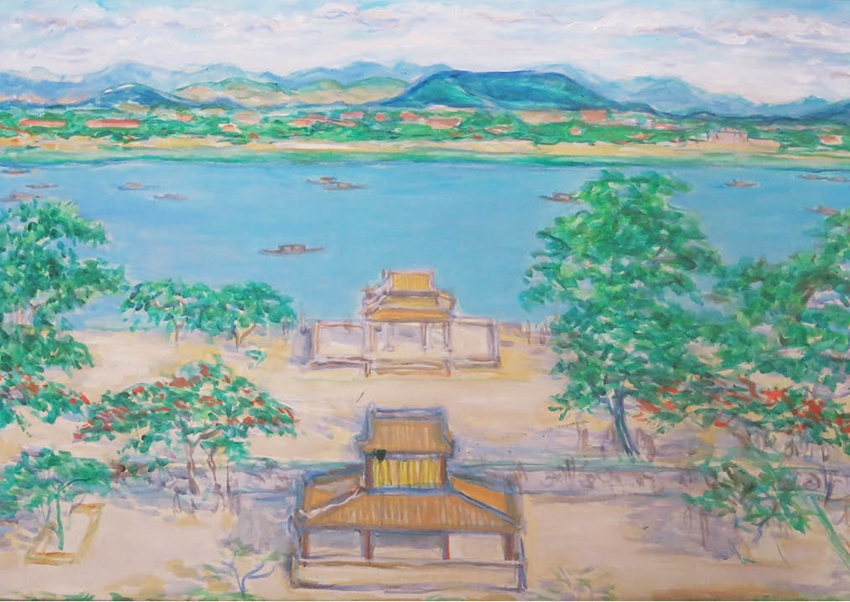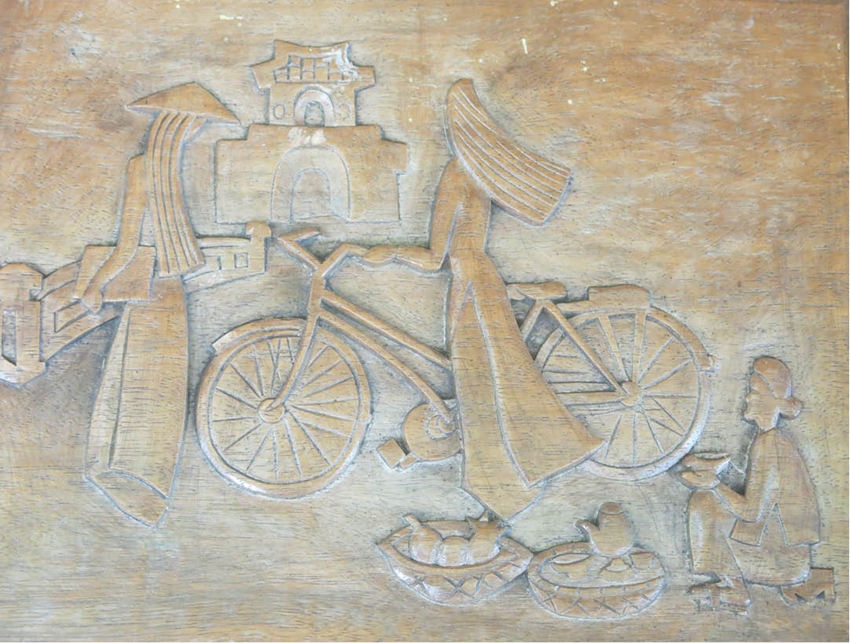    |
 |
| A landscape of Hue by Thai Nguyen Ba |
Talented
Introducing the artworks by Thai Nguyen Ba with all her affection, Dr. Thai Kim Lan, his younger sister, says his life was like a game of an artist. He saved all his life for art. He tried everything which was related to art.
As a child, Thai Nguyen Ba had a gift for fine arts. He could sketch portraits very quickly and he did it anytime and anywhere. After finishing his high school study at Quoc Hoc, Hue in 1955, Thai Ba passed the entrance exam into Gia Dinh-Saigon National College of Fine Arts and became a student of Le van De, one of the typical neoclassical painters in Southern Vietnam at the time.
In 1958, Thai Ba won the silver medal in a contest promoting Vietnam tourism and the second prize of the whole course of study with the theme of the four women’s virtues: diligent work, tasteful appearance, proper speech, and good morality. He then received a scholarship to study abroad at Paris National College of Fine Arts in France in 1960.
Becoming a professional artist, Thai Ba explored various materials such as silk, printing on canvas, oil paint, woodcarving, lacquer, etc. He used different techniques to create an artwork.
While in the U.S. Thai Ba owned a pottery kiln. Returning to Hue, he had a carpentry workshop to make furniture. All the tables and chairs at Lan Vien Co Tich were designed by him.
    |
 |
| Hue was present in many artworks by Thai Nguyen Ba |
“Thai Ba was always open-minded and thoughtful about the outside world. He wanted to show the beauty of nature and people in various forms of art such as woodcarving, silk painting, and lacquer. Traveling to many places in the world, he stopped at each place to learn about how people used their materials in their artworks,” said Thai Kim Lan.
Homeland was always present in every stroke by Thai Ba. Many of his paintings were about the Perfume River, the Truong Tien bridge, the royal mausoleums, the temples, and the countryside. He portrayed the ancient and calm city of Hue.
His major colors in Thai Ba’s paintings were blue and green. The colors of water and leaves combined with the color of the sky to become his own distinctive color. Viewers can see the joy in all of his landscapes.
In 1969, Thai Ba was sponsored by UNESCO to come to America to paint for the United Nations Children's Fund (UNICEF). While in the U.S. his very Hueish paintings appeared in special magazines about Hue such as Nhớ Huế (Missing Hue), Phượng Vỹ (Flamboyant), Cố Đô (Ancient Capital), Thua Thien Hue, etc.
In 1990, Thai Ba returned to Hue and immersed himself in Thanh Tien paper flowers and folk paintings. He contributed his part to the collection of pottery so that Hue has the Museum of Perfume River Ancient Pottery as it is today.
In 1992, Thai Ba drew a very impressive map called “Việt Nam Giang sơn Gấm vóc.” Each place was illustrated with a typical “cultural specialty" of the region.
His first teacher
Ton That Dao was considered the first teacher to bring Thai Ba to painting. Alive, it was Ton That Dao who discovered the gift for painting in Thai Ba and encouraged him to take up painting.
“Ton That Dao was my father’s cousin and my grandma’s nephew, so he was very close to my family. As a young girl, I usually followed my grandma to visit her family. Every time I saw him, he was sitting by his easel. His first subject matter was his family members. He painted his sisters in their daily lives. The beauty of nature and people, the long hair, the polite speech, and the elegant air, etc., inspired him and he painted them,” said Thai Kim Lan.
As a child, Thai Ba often drew sketches. Every time family members gathered; Thai Ba secretly sketched their portraits. Though he did it very fast, he could portray each person's personality. Ton That Dao saw the gift for painting in Thai Ba and encouraged him to specialize in painting. As a result, Thai Ba chose to attend a college of fine arts.
“Ton That Dao often visited my grandma. Every time he came, the first person he asked was Ba, as if he was looking for his disciple. He loved my brother very much and always asked about him. He also followed my brother’s painting journey,” recalled Thai Kim Lan.
Although Thai Ba always wanted to escape the influence of his predecessors, in painting, he was affected by Ton That Dao. “His subject matters could also be found in the works by Ton That Dao. His sensitivity to landscape and the beauty of Hue women, and his acuteness in his strokes, especially in lacquer and silk paintings, were heavily influenced by Ton That Dao,” commented Thai Kim Lan.